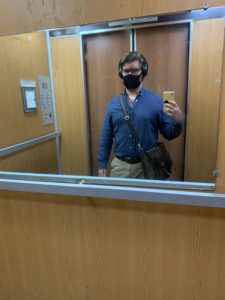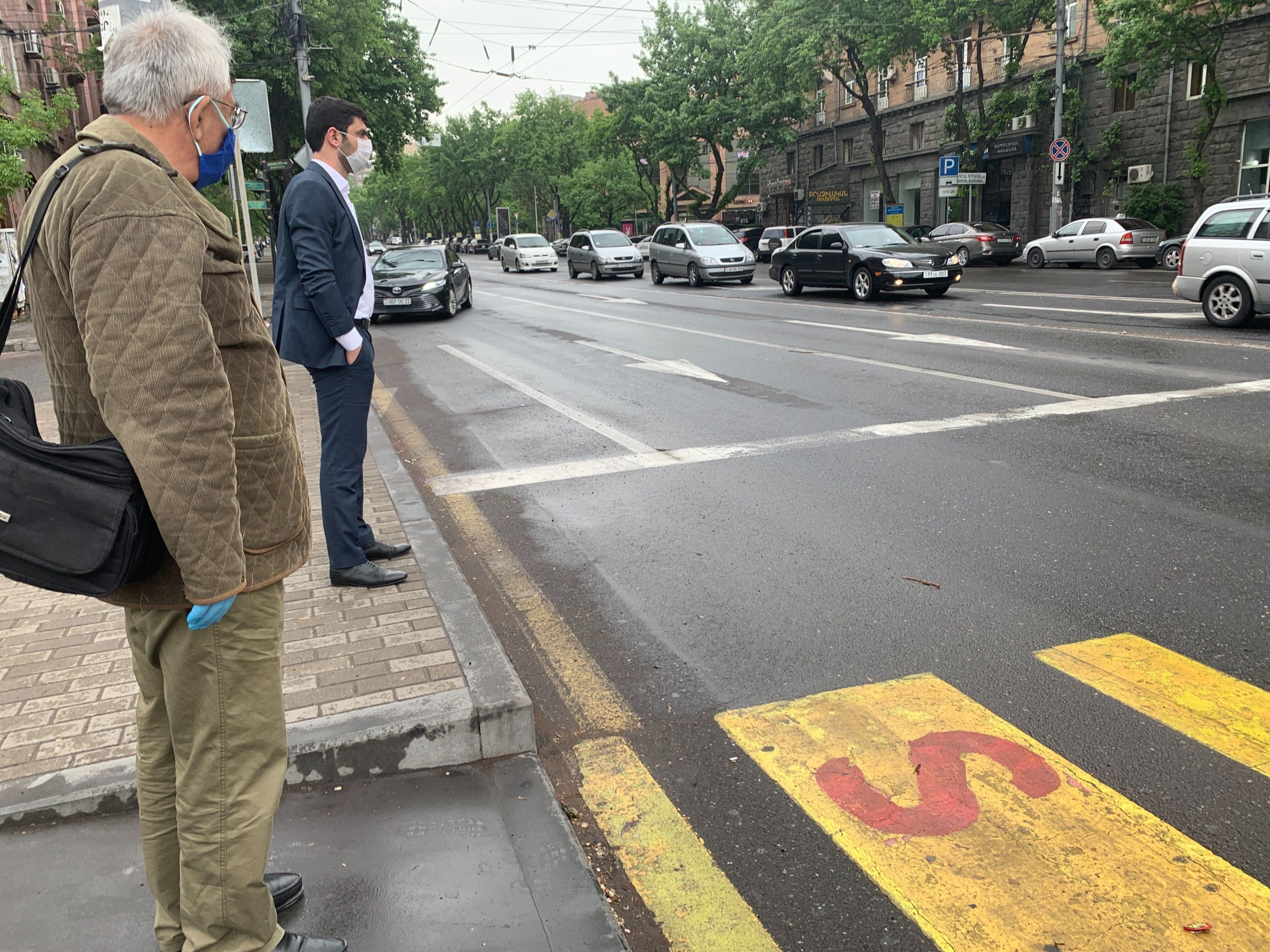Last week, I started going back to the office. After 50 days of ordering groceries online, watching Tiger King with my wife, teaching my three-year-old the basics of hockey (Canadians, eh?) and anxiously following daily COVID-19 status reports—both in Armenia and around the world—I was eager to explore.
I figured a regular walk to and from my empty office would pose no immediate health risk, but provide me with an impetus to exercise and concentrate on my work free from distractions of home. With my Armenian passport in my pocket, “Made in Armenia” microcloth mask hung across my face and surgical gloves, I headed out into society for the first time since mid-March.

Walking up Yerevan’s mostly-deserted boulevards, I immediately noticed just how crisp Mount Ararat looked, towering above the city. It felt so close that I resisted an urge to reach out and touch it. But that revelation paled in comparison to events on the ground – or rather, lack thereof. Indeed, save for the occasional car racing up the road and thinly-spaced pedestrians dotting the sidewalk, the city was as empty as I’d ever seen it. That clean mountain air I was surprised to be breathing in was the result of nitrogen dioxide levels dropping almost five percent in Yerevan between March and April.
Continuing my walk, I noted a police officer wearing a full mask and gloves, then another, and another. In fact, I have yet to encounter a police officer not fully clad in PPE. Admittedly, that says little about their interest in enforcing these hygiene standards on the dozens of passers-by whose own commitment to the practice varied between very strict and none whatsoever.
I also became acutely aware of the increasingly conspicuous lockdown violations around town. Bored citizens having endured weeks of confinement, perhaps drawn by clement weather, or emboldened by what some call “inconsistent enforcement” by police (or perhaps both) have been venturing outside in even greater numbers. Seniors played intense games of nardi on the sidewalk. Others crammed into corner stores to buy supplies. By far, the most egregious violations came in the form of black-clad young men sporting Ringo Starr haircuts congregating in groups to smoke cigarettes, throw sunflower seeds on the ground and greet each other with passionate embraces and handshakes. The Prime Minister’s social distancing advice “to change behavior” came to mind. Not so easy in practice.
But while such scenes were common, they weren’t the norm. Well-spaced queues of patiently waiting patrons stood in front of every bank or other business which I walked past. Their employees invariably wore masks and gloves. The vast majority of Armenians have stuck to the measures in one form or another, but even the most brutal police state can only maintain confinement for so long.

But with the “reopening date” of May 4th fast approaching and the rate of daily new infections steadily rising again after a three-week lull, concern had grown over the authorities’ wisdom in reopening so soon. Had the government flinched first in its face-off with the virus? Were they counting their losses and defaulting to herd immunity? Worse, had they chosen the economy over public safety?
At the risk of adding the titles of armchair-public health expert and armchair-epidemiologist to my list of armchair professions, I’ll venture a guess that perhaps this is the right move.
According to the Prime Minister, the decision had been informed on the one hand by global projections showing new COVID-19 infections continuing well into next year despite social distancing, and on the other, by enhancements in the public health system’s ability to mitigate the spread. Since no country is equipped to sustain its entire population on welfare indefinitely, the objective now is to regain a semblance of life-as-usual until a vaccine becomes widely available. As Pashinyan said, “The prospect of life under lockdown for the next year is not a realistic one.”
In that respect, Armenia’s “experiment” is no different from that of dozens of other European nations which relaxed lockdown measures on that same day. Ultimately, the cost of economic depression and social well-being must be weighed against the cost of infection, and pragmatic decisions taken.
So why then have we endured six weeks of lockdown?
At some point throughout the course of this State of Emergency, we seem to have lost sight of what lockdowns are meant to accomplish. Some apparently entertain a fanciful notion that the virus could have somehow been vanquished by now if only quarantines had been enforced sooner, longer or more severely.
But experiences from virtually every other country on the planet in battling the virus tell us that no amount of lockdowns, penalties, arrests or other violations of our constitutional rights could have defeated the pandemic outright. Countries like Singapore and the UAE, which had garnered early praise for their quick and drastic responses, are now seeing rates go up again. In fact, the only countries which have claimed victory over the virus—Turkmenistan, North Korea and China— owe their success to a highly unusual tool at their disposal: lying about it and kidnapping any journalist who reports otherwise.
For public health authorities in Armenia and indeed across the planet, the question was never about whether the number of cases might continue their ascent, but when. The answer would depend on lockdowns.
What keeps public health officials awake at night is not so much the novel coronavirus’ lethality (currently 1.4 percent in Armenia), but rather its highly contagious nature, which makes it nearly impossible to quickly identify or effectively contain once it spreads. The real calamity comes when an unprepared medical system gets so overwhelmed with COVID-19 cases that it loses the capacity to treat other patients with otherwise non-lethal conditions. To avoid such a scenario, social distancing measures are designed to slow contagion rates just enough to spread new cases over a longer period, allowing first responders to cope with a never-before-seen virus.
Health Minister Arsen Torosyan said as much when Armenia first went into lockdown on March 24. And over the weeks that followed, Armenia pulled off a truly remarkable achievement in re-purposing not only its entire medical network, but every institution in the country to buttress the effects of the virus. The Health Ministry made good use of that respite to retrofit 16 medical centers across the country, and retrain thousands of medical personnel to treat infectious diseases. An entire state-of-the-art hospital was erected from the ground up to accommodate more patients. Combined, these efforts helped boost capacity to treat several hundred cases in early March to over four-thousand by the first week of May (four times the current number of active cases), including 1,500 hospital beds. First responders have worked tirelessly to save the lives of over 1,600 patients already.
At the same time, the Health Ministry coordinated with international organizations to enhance contact-tracing techniques, expand testing resources and boost domestic manufacturing capacity which have already been churning out new ventilators, medical gowns and masks. Meanwhile, labs across the country race to put out as many testing kits as possible to meet the desired rate of 10,000 tests per week. Thirty-thousand tests have already been conducted since the start of the pandemic. A drop in a bucket perhaps, but still.
On the home front, Armenia reorganized itself to tackle the worst of the economic fallout from the global pandemic. The government released 12 billion AMD ($25 million) in emergency assistance to cover rents, salaries, loans, utilities, tuition fees, pensions, business operations and childcare for over one million furloughed workers. Armenians both in the homeland and the diaspora coordinated private fundraising efforts to fill in the remaining gaps. Educators figured out how to bring their classrooms online in a veritable ‘trial by fire.’ The process wasn’t always smooth, however. Databases were incomplete, funds weren’t always immediately available, quarantines were unevenly enforced, hygienic guidelines took time, but ultimately we adapted.
Armenia was originally projected to hit 2,000 cases of COVID-19 by April 14. That threshold wasn’t crossed until 16 days later on April 30. So while the number of new cases is once again rising, the Armenian medical system now has the knowledge, equipment and capacity to care for them. It is in this context that Armenia decided to reopen.
“This isn’t victory, but a new phase,” Pashinyan said on Sunday. Those words feel like a punch in the gut for those of us who had locked our doors back in March hoping to emerge to a wild block party once this was all over. Catharsis.
Cases will continue to rise. As Thomas Hobbes observed in the 17th century: humans, like atoms, are always in motion. Eventually we might stop counting. Only once this is over will we be able to critically assess the efficacy of our response. But, by fostering an atmosphere of transparency, public trust and solidarity between citizens and the government, Armenia has achieved a level of preparedness that neighboring ex-Soviet autocracies are struggling to meet through the usual toolkit of lies, posturing and crackdowns.
When I walked to work on Monday, I got the distinct impression that, despite the lockdown being lifted, there were fewer people outside than last week—a phenomenon I observed again yesterday and today as well. I also notice way more masks. As I venture beyond my usual route, every business I walk by seems to be taking social distancing seriously. Masks are ubiquitous, as are gloves. Perhaps the sight of tables in the crowded outdoor seating areas around the Cascade all featuring liquid hand sanitizing gel containers offers a glimpse of life returning to normal in the era of COVID-19. Or maybe it’s the lady who crossed the street to avoid me this morning.


Thanks for your observations Raffi. It is clear that globally the infirm and elderly with reduced immunity are the most vulnerable to death after contracting the virus on top of their already high risk conditions. I believe the lockdowns could have been much more selective and thus more effective without the need for massive costly one size fits all approach.